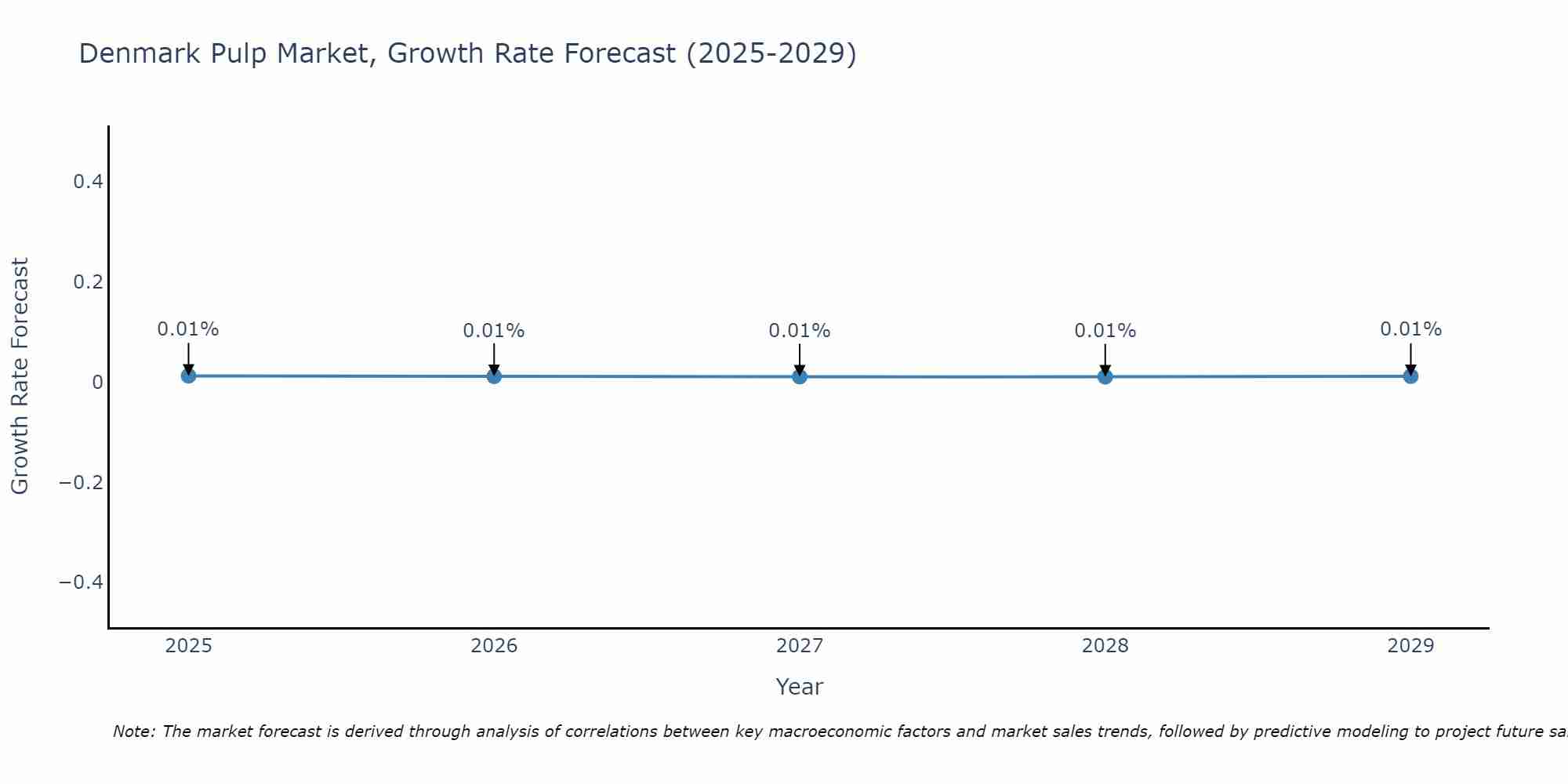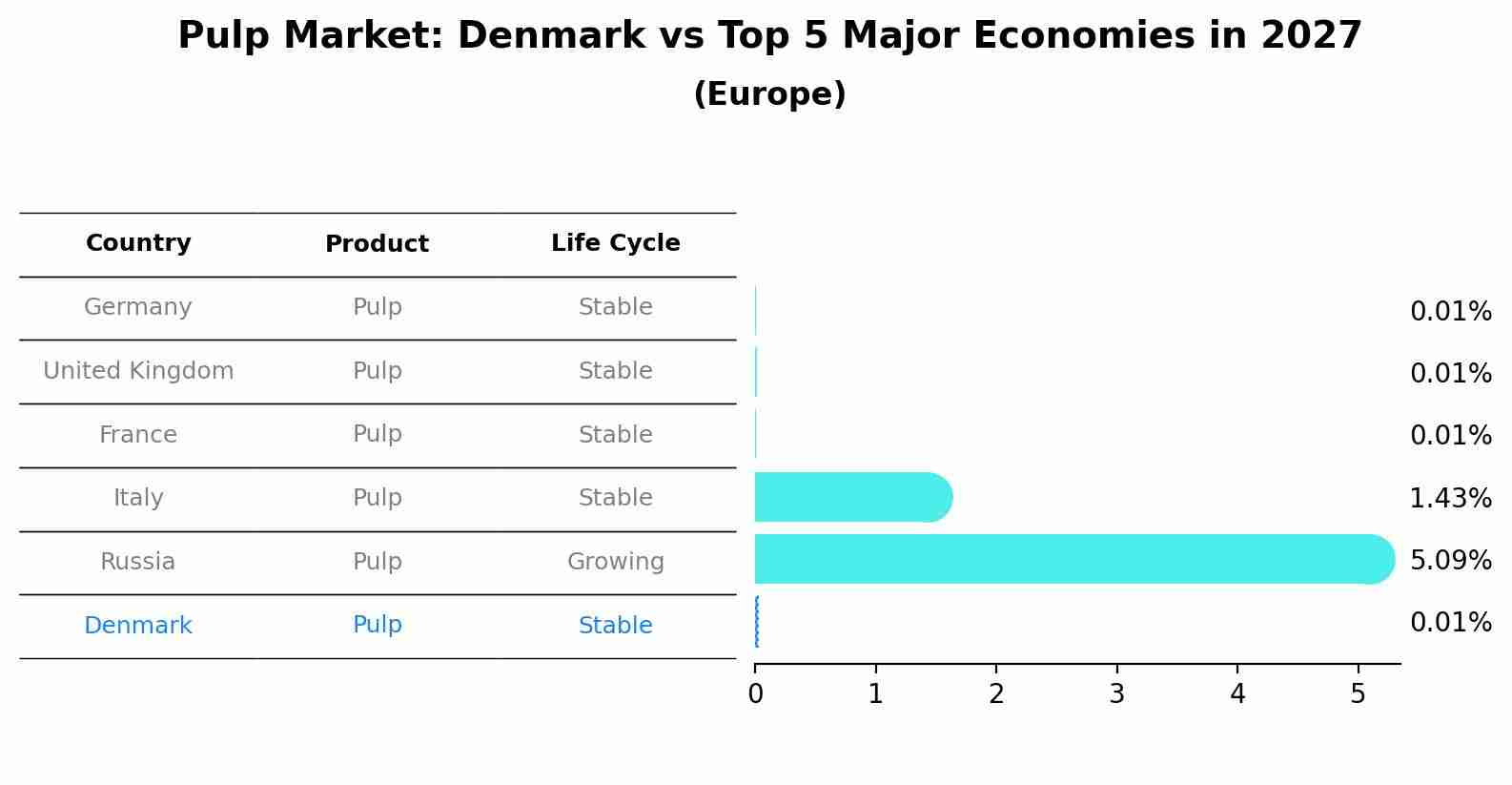Denmark Pulp Market (2025-2031) | Value, Growth, Companies, Outlook, Forecast, Industry, Revenue, Segmentation, Analysis, Share, Trends & Size
| Product Code: ETC4650503 | Publication Date: Nov 2023 | Updated Date: Sep 2025 | Product Type: Market Research Report | |
| Publisher: 6Wresearch | Author: Shubham Deep | No. of Pages: 60 | No. of Figures: 30 | No. of Tables: 5 |
Denmark Pulp Market Size Growth Rate
The Denmark Pulp Market is projected to witness mixed growth rate patterns during 2025 to 2029. Although the growth rate starts strong at 0.01% in 2025, it steadily loses momentum, ending at 0.01% by 2029.

Pulp Market: Denmark vs Top 5 Major Economies in 2027 (Europe)
Denmark's Pulp market is anticipated to experience a stable growth rate of 0.01% by 2027, reflecting trends observed in the largest economy Germany, followed by United Kingdom, France, Italy and Russia.

Denmark Pulp Market Overview
The Pulp Market in Denmark is closely linked to the broader pulp and paper industry, with an emphasis on sustainable practices. The demand for pulp, particularly for packaging materials, is being driven by the growth of e-commerce and the need for environmentally friendly packaging solutions. The Danish government encourages the use of sustainably sourced raw materials and promotes recycling initiatives, contributing to a favorable market environment. Innovations in pulp production processes, including the use of alternative fibers, are expected to enhance competitiveness and sustainability in the market.
Drivers of the market
The pulp market in Denmark is primarily driven by the rising demand for biodegradable and sustainable products across various industries. The global shift towards reducing plastic use has increased the demand for pulp-based packaging solutions. Additionally, the growing paper and tissue industries are fueling demand for pulp products. Innovations in pulp processing technologies, aimed at improving efficiency and reducing environmental impact, are also driving market growth. Increased focus on circular economy practices and sustainable forestry further supports the demand for pulp in Denmark.
Challenges of the market
Similar to the broader pulp and paper market, the pulp market grapples with sustainability concerns and regulatory pressures regarding deforestation and carbon emissions. Manufacturers face challenges in securing a stable supply of raw materials, as global competition for wood and fiber resources increases. Additionally, the need for technological advancements to enhance production efficiency and reduce environmental impact is pressing. Economic fluctuations can also influence demand for pulp products, making it essential for companies to adopt agile strategies to respond to changing market dynamics.
Government Policy of the market
The Danish pulp market is influenced by government policies that emphasize sustainability and responsible sourcing of raw materials. The government supports initiatives aimed at reducing the environmental impact of pulp production, such as encouraging the use of renewable energy in manufacturing processes and promoting circular economy practices. Additionally, Denmark follows EU regulations related to emissions control and waste management in the pulp industry, ensuring that companies operate in an environmentally friendly manner.
Key Highlights of the Report:
- Denmark Pulp Market Outlook
- Market Size of Denmark Pulp Market, 2024
- Forecast of Denmark Pulp Market, 2031
- Historical Data and Forecast of Denmark Pulp Revenues & Volume for the Period 2021-2031
- Denmark Pulp Market Trend Evolution
- Denmark Pulp Market Drivers and Challenges
- Denmark Pulp Price Trends
- Denmark Pulp Porter`s Five Forces
- Denmark Pulp Industry Life Cycle
- Historical Data and Forecast of Denmark Pulp Market Revenues & Volume By Types for the Period 2021-2031
- Historical Data and Forecast of Denmark Pulp Market Revenues & Volume By Chemical Pulp for the Period 2021-2031
- Historical Data and Forecast of Denmark Pulp Market Revenues & Volume By Mechanical & Semi Chemical Pulp for the Period 2021-2031
- Historical Data and Forecast of Denmark Pulp Market Revenues & Volume By Non Wood Pulp for the Period 2021-2031
- Historical Data and Forecast of Denmark Pulp Market Revenues & Volume By Applications for the Period 2021-2031
- Historical Data and Forecast of Denmark Pulp Market Revenues & Volume By Corrugating Materials for the Period 2021-2031
- Historical Data and Forecast of Denmark Pulp Market Revenues & Volume By Printing & Writing for the Period 2021-2031
- Historical Data and Forecast of Denmark Pulp Market Revenues & Volume By Carton Board for the Period 2021-2031
- Historical Data and Forecast of Denmark Pulp Market Revenues & Volume By Tissue for the Period 2021-2031
- Historical Data and Forecast of Denmark Pulp Market Revenues & Volume By Newsprint for the Period 2021-2031
- Historical Data and Forecast of Denmark Pulp Market Revenues & Volume By Wrapping Paper for the Period 2021-2031
- Historical Data and Forecast of Denmark Pulp Market Revenues & Volume By Kraft Paper for the Period 2021-2031
- Denmark Pulp Import Export Trade Statistics
- Market Opportunity Assessment By Types
- Market Opportunity Assessment By Applications
- Denmark Pulp Top Companies Market Share
- Denmark Pulp Competitive Benchmarking By Technical and Operational Parameters
- Denmark Pulp Company Profiles
- Denmark Pulp Key Strategic Recommendations
Frequently Asked Questions About the Market Study (FAQs):
1 Executive Summary |
2 Introduction |
2.1 Key Highlights of the Report |
2.2 Report Description |
2.3 Market Scope & Segmentation |
2.4 Research Methodology |
2.5 Assumptions |
3 Denmark Pulp Market Overview |
3.1 Denmark Country Macro Economic Indicators |
3.2 Denmark Pulp Market Revenues & Volume, 2021 & 2031F |
3.3 Denmark Pulp Market - Industry Life Cycle |
3.4 Denmark Pulp Market - Porter's Five Forces |
3.5 Denmark Pulp Market Revenues & Volume Share Segmentations, 2021 & 2031F |
3.6 Denmark Pulp Market Revenues & Volume Share, By Applications, 2021 & 2031F |
4 Denmark Pulp Market Dynamics |
4.1 Impact Analysis |
4.2 Market Drivers |
4.2.1 Increasing demand for sustainable and eco-friendly packaging solutions |
4.2.2 Growing awareness about the importance of recycling and reducing waste |
4.2.3 Technological advancements leading to improved production efficiency in the pulp industry |
4.3 Market Restraints |
4.3.1 Fluctuating prices of raw materials such as wood pulp |
4.3.2 Regulatory challenges related to environmental standards and certifications |
4.3.3 Competition from alternative packaging materials like plastics and metals |
5 Denmark Pulp Market Trends |
6 Denmark Pulp Market Segmentations |
6.1 Denmark Pulp Market Segmentations |
6.1.1 Overview and Analysis |
6.1.2 Denmark Pulp Market Revenues & Volume, By Chemical Pulp, 2021-2031F |
6.1.3 Denmark Pulp Market Revenues & Volume, By Mechanical & Semi Chemical Pulp, 2021-2031F |
6.1.4 Denmark Pulp Market Revenues & Volume, By Non Wood Pulp, 2021-2031F |
6.2 Denmark Pulp Market, By Applications |
6.2.1 Overview and Analysis |
6.2.2 Denmark Pulp Market Revenues & Volume, By Corrugating Materials, 2021-2031F |
6.2.3 Denmark Pulp Market Revenues & Volume, By Printing & Writing, 2021-2031F |
6.2.4 Denmark Pulp Market Revenues & Volume, By Carton Board, 2021-2031F |
6.2.5 Denmark Pulp Market Revenues & Volume, By Tissue, 2021-2031F |
6.2.6 Denmark Pulp Market Revenues & Volume, By Newsprint, 2021-2031F |
6.2.7 Denmark Pulp Market Revenues & Volume, By Wrapping Paper, 2021-2031F |
7 Denmark Pulp Market Import-Export Trade Statistics |
7.1 Denmark Pulp Market Export to Major Countries |
7.2 Denmark Pulp Market Imports from Major Countries |
8 Denmark Pulp Market Key Performance Indicators |
8.1 Percentage of recycled content in pulp production |
8.2 Energy efficiency improvements in pulp manufacturing processes |
8.3 Adoption rate of sustainable packaging solutions in Denmark's consumer market |
9 Denmark Pulp Market - Opportunity Assessment |
9.1 Denmark Pulp Market Opportunity Assessment Segmentations, 2021 & 2031F |
9.2 Denmark Pulp Market Opportunity Assessment, By Applications, 2021 & 2031F |
10 Denmark Pulp Market - Competitive Landscape |
10.1 Denmark Pulp Market Revenue Share, By Companies, 2024 |
10.2 Denmark Pulp Market Competitive Benchmarking, By Operating and Technical Parameters |
11 Company Profiles |
12 Recommendations | 13 Disclaimer |
- Single User License$ 1,995
- Department License$ 2,400
- Site License$ 3,120
- Global License$ 3,795
Search
Related Reports
- Europe Flooring Market (2025-2031) | Outlook, Share, Industry, Trends, Forecast, Companies, Revenue, Size, Analysis, Growth & Value
- Saudi Arabia Manlift Market (2025-2031) | Outlook, Size, Growth, Trends, Companies, Industry, Revenue, Value, Share, Forecast & Analysis
- Uganda Excavator, Crane, and Wheel Loaders Market (2025-2031) | Strategy, Consumer Insights, Analysis, Investment Trends, Opportunities, Growth, Size, Share, Industry, Revenue, Segments, Value, Segmentation, Supply, Forecast, Restraints, Outlook, Competition, Drivers, Trends, Demand, Pricing Analysis, Competitive, Strategic Insights, Companies, Challenges
- Rwanda Excavator, Crane, and Wheel Loaders Market (2025-2031) | Strategy, Consumer Insights, Analysis, Investment Trends, Opportunities, Growth, Size, Share, Industry, Revenue, Segments, Value, Segmentation, Supply, Forecast, Restraints, Outlook, Competition, Drivers, Trends, Demand, Pricing Analysis, Competitive, Strategic Insights, Companies, Challenges
- Kenya Excavator, Crane, and Wheel Loaders Market (2025-2031) | Strategy, Consumer Insights, Analysis, Investment Trends, Opportunities, Growth, Size, Share, Industry, Revenue, Segments, Value, Segmentation, Supply, Forecast, Restraints, Outlook, Competition, Drivers, Trends, Demand, Pricing Analysis, Competitive, Strategic Insights, Companies, Challenges
- Angola Excavator, Crane, and Wheel Loaders Market (2025-2031) | Strategy, Consumer Insights, Analysis, Investment Trends, Opportunities, Growth, Size, Share, Industry, Revenue, Segments, Value, Segmentation, Supply, Forecast, Restraints, Outlook, Competition, Drivers, Trends, Demand, Pricing Analysis, Competitive, Strategic Insights, Companies, Challenges
- Israel Intelligent Transport System Market (2025-2031) | Strategy, Consumer Insights, Analysis, Investment Trends, Opportunities, Growth, Size, Share, Industry, Revenue, Segments, Value, Segmentation, Supply, Forecast, Restraints, Outlook, Competition, Drivers, Trends, Demand, Pricing Analysis, Competitive, Strategic Insights, Companies, Challenges
- Uganda Precast and Aggregate Market (2025-2031) | Strategy, Consumer Insights, Analysis, Investment Trends, Opportunities, Growth, Size, Share, Industry, Revenue, Segments, Value, Segmentation, Supply, Forecast, Restraints, Outlook, Competition, Drivers, Trends, Demand, Pricing Analysis, Competitive, Strategic Insights, Companies, Challenges
- Australia IT Asset Disposal Market (2025-2031) | Strategy, Consumer Insights, Analysis, Investment Trends, Opportunities, Growth, Size, Share, Industry, Revenue, Segments, Value, Segmentation, Supply, Forecast, Restraints, Outlook, Competition, Drivers, Trends, Demand, Pricing Analysis, Competitive, Strategic Insights, Companies, Challenges
- UAE Building Thermal Insulation Market Outlook (2025-2031) | Revenue, Companies, Share, Trends, Growth, Size, Forecast, Industry, Analysis & Value
Industry Events and Analyst Meet
Our Clients
Whitepaper
- Middle East & Africa Commercial Security Market Click here to view more.
- Middle East & Africa Fire Safety Systems & Equipment Market Click here to view more.
- GCC Drone Market Click here to view more.
- Middle East Lighting Fixture Market Click here to view more.
- GCC Physical & Perimeter Security Market Click here to view more.
6WResearch In News
- Doha a strategic location for EV manufacturing hub: IPA Qatar
- Demand for luxury TVs surging in the GCC, says Samsung
- Empowering Growth: The Thriving Journey of Bangladesh’s Cable Industry
- Demand for luxury TVs surging in the GCC, says Samsung
- Video call with a traditional healer? Once unthinkable, it’s now common in South Africa
- Intelligent Buildings To Smooth GCC’s Path To Net Zero













